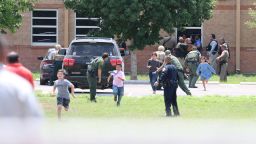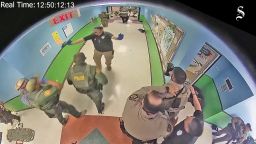In the first comprehensive look by a government agency into the Uvalde elementary school massacre, a Texas House investigative committee released a preliminary report Sunday outlining a series of failures by multiple law enforcement agencies in their response at the scene.
The 77-page “interim report,” first made available to the victims’ families, described “an overall lackadaisical approach” by nearly 400 officers who responded, a number of whom were from federal agencies.
Bodycam footage of first responders that was provided to CNN also gives a closer look at how law enforcement navigated the agonizing 77 minutes at Robb Elementary, which ended as the second-deadliest shooting ever at a K-12 school in the US.
The report comes after finger-pointing from law enforcement agencies in the aftermath of the shooting, as well as local officials decrying a lack of transparency and victims’ families learning on a piecemeal basis what more could have been done to save their loved ones.
Here are five key takeaways from the report and videos:
Law enforcement shares ‘systemic responsibility’
The report found “the entirety of law enforcement and its training, preparation, and response shares systemic responsibility for many missed opportunities.”
According to the report, police who made entry knew there had been gunfire, evidenced by a “cloud of debris” in the hallway, bullet holes in the walls and spent rifle casings on the floor.
But there was no evidence officers had “any contemporaneous understanding, as they arrived in the building, that teachers and students just then had been shot inside the classrooms.”
It would be more than an hour before officers finally breached the classroom, killing the shooter.
According to the committee’s report, first responders “lost critical momentum” by treating the situation as a “barricaded subject” scenario, which calls for a more measured response compared to an active shooter.
“Correcting this error should have sparked greater urgency to immediately breach the classroom by any possible means, to subdue the attacker, and to deliver immediate aid” to victims, the report says.

If they had recognized the situation as an active shooter scenario, they should have prioritized the “rescue of innocent victims over the precious time wasted in a search for door keys, and shields to enhance the safety of law enforcement responders,” the report states.
Of the 376 responders on scene, 149 were from the United States Border Patrol, 14 were from the Department of Homeland Security and 91 were from the Texas Department of Public Safety. The report did not state when officers from each responding agency arrived on scene.
CNN has reached out to Texas DPS, US Border Patrol, the Uvalde School District, the city’s police department and the Uvalde district attorney for comment, among others.
‘Lack of effective incident command’
In a hearing before a Texas Senate committee last month, Texas Department of Public Safety Director Col. Steven McCraw called authorities’ response an “abject failure,” placing blame at the feet of the on-scene commander, who state authorities have identified as school district police chief Pedro “Pete” Arredondo.

But Arredondo, who was put on administrative leave by the school district, did not consider himself incident commander, the report says, echoing comments he made to the Texas Tribune last month.
“My approach and thought was responding as a police officer. And so I didn’t title myself,” Arredondo said in the investigative report.
The report also noted others could have assumed command.
Advanced Law Enforcement Rapid Response Training “teaches that any law enforcement officer can assume command, that somebody must assume command, and that an incident commander can transfer responsibility as an incident develops,” it says.
“That did not happen at Robb Elementary, and the lack of effective incident command is a major factor that caused other vital measures to be left undone,” according to the report.
Breakdown in communication
The report attributed some of the response failures to a breakdown in communication, in which information known to some outside the school may not have been relayed to those on the inside.
“Notably, nobody ensured that responders making key decisions inside the building received information that students and teachers had survived the initial burst of gunfire, were trapped in (classrooms), and had called out for help,” the report says.
Arredondo previously told the Texas Tribune he left his two radios outside the school because he wanted his hands free to hold his gun.
Robb Elementary had its own issues, per the investigative report, which found that poor WiFi “likely delayed the lockdown alert” the day of the shooting. Not all teachers received the report immediately, and the school intercom was not used to communicate during the lockdown.
“As a result, not all teachers received timely notice of the lockdown,” the report says.
Additionally, the school had what the report calls “recurring problems” with doors and locks, including the locking mechanism to room 111, which was “widely known to be faulty, yet it was not repaired.”
“Robb Elementary had a culture of noncompliance with safety policies requiring doors to be kept locked, which turned out to be fatal,” the report says.
New video captures confusion and chaos
Dramatic body camera footage given first to CNN by Uvalde Mayor Don McLaughlin provides a close-up view of the law enforcement response to the unfolding massacre.
The video was released to CNN Sunday, the same day the interim report was released. It reveals officers smashing windows and pulling children out of other classrooms at the school as well as inside a hallway fumbling with keys and failing to pry open a door near to where a gunman had control of two classrooms full of dead, dying and terrified children and teachers.
The footage shows close-ups from just outside Classrooms 111 and 112 and reveals conversations between officers and pleas to the shooter.
CNN watched hours of the body camera footage, including revealing new views from Uvalde Police Sgt. Daniel Coronado, who was one of the first on scene at 11:35 a.m., and UPD Officer Justin Mendoza.
According to the video, Coronado identifies the shooter as a “male subject with an AR” at 11:39 a.m., minutes after the gunman first entered the classrooms and shortly after he fired at responding officers.
There is initial confusion as to whether the gunman was in an office, but a call goes out at 11:42 a.m. that it’s the classroom of Eva Mireles, a teacher who called to tell her husband, Uvalde Police officer Ruben Ruiz, that she has been shot.
The bodycam from Mendoza at around 12:11 p.m. shows officers learning that BORTAC – a Border Patrol rapid response team – is still 30 minutes away. Around the same time, Coronado’s bodycam picks up someone calling out to the shooter in English and Spanish to surrender.
A dispatcher in Mendoza’s video can be heard saying there is a child on the line from “Room 12” talking of a “room full of victims,” which was relayed to the acting Uvalde PD chief on the scene Lt. Mariano Pargas, who makes no audible comment.
On Sunday, the city of Uvalde announced that Pargas had been placed on administrative leave to further investigate his role in the law enforcement response. CNN has reached out to Pargas for comment and has not received an answer.
New details on shooter’s background
The report did not name the shooter nor show his image, “so as not to glorify him,” it said, but did offer information about his background, both at home and school as a student of the Uvalde Consolidated Independent School District.
Though he had “few disciplinary issues,” he struggled academically, having completed only the ninth grade by the time he was 17. And the school made “no meaningful intervention” before he was finally involuntarily withdrawn from school for poor performance and excessive absences last October.
Because of those absences, the report says, there was “no information actually known to the school district that should have identified this attacker as a threat to any school campus.”
But the shooter sent messages about guns to some of his contacts on social media, the report says, and he would suggest he was going to “do something” they would hear about on the news.
Some users might have reported the behavior to the social media platforms, the report indicates, but the platforms “appear to have not done anything in response.”
Before the shooting, various members of the gunman’s family knew he had “asked for help in making straw gun purchases which would have been illegal,” the report says. “Family members uniformly refused to buy guns for him.”
CNN’s Travis Caldwell, Matthew J. Friedman and Elizabeth Joseph contributed to this report.









